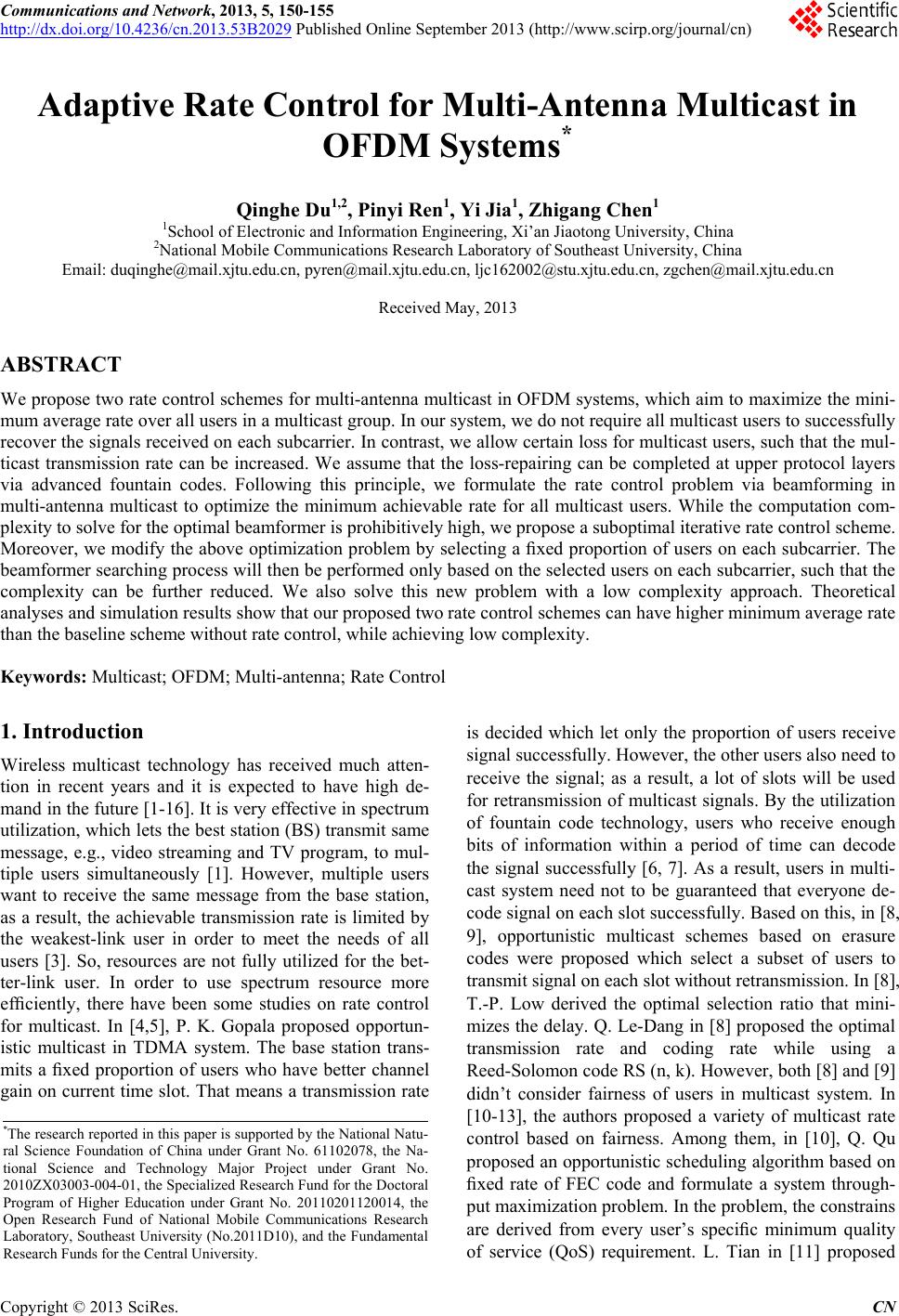 Communications and Network, 2013, 5, 150-155 http://dx.doi.org/10.4236/cn.2013.53B2029 Published Online September 2013 (http://www.scirp.org/journal/cn) Adaptive Rate Control for Multi-Antenna Multicast in OFDM Systems* Qinghe Du1,2, Pinyi Ren1, Yi Jia1, Zhigang Chen1 1School of Electronic and Information Engineering, Xi’an Jiaotong University, China 2National Mobile Communications Research Laboratory of Southeast University, China Email: duqinghe@mail.xjtu.edu.cn, pyren@mail.xjtu.edu.cn, ljc162002@stu.xjt u.edu.cn, z g c hen@mail. x jt u.edu.cn Received May, 2013 ABSTRACT We propose two rate control sch emes for multi-antenna multicast in OFDM systems, which aim to maximize the mini- mum average rate over all users in a multicast group. In our system, we do not require all multicast users to successfully recover the signals received on each subcarrier. In contrast, we allow certain loss for multicast users, such that the mul- ticast transmission rate can be increased. We assume that the loss-repairing can be completed at upper protocol layers via advanced fountain codes. Following this principle, we formulate the rate control problem via beamforming in multi-antenna multicast to optimize the minimum achievable rate for all multicast users. While the computation com- plexity to solve for the optimal beamformer is prohibitively high, we propose a suboptimal iterative rate control scheme. Moreover, we modify the above optimization problem by selecting a fixed proportion of users on each subcarrier. The beamformer searching process will then be performed only based on the selected users on each subcarrier, such that the complexity can be further reduced. We also solve this new problem with a low complexity approach. Theoretical analyses and simulation results show that our proposed two rate control schemes can have higher minimum average rate than the baseline scheme without rate control, while achieving low complexity. Keywords: Multicast; OFDM; Multi-antenna; Rate Control 1. Introduction Wireless multicast technology has received much atten- tion in recent years and it is expected to have high de- mand in the future [1-16]. It is very effective in spectru m utilization, which lets the best statio n (BS) transmit same message, e.g., video streaming and TV program, to mul- tiple users simultaneously [1]. However, multiple users want to receive the same message from the base station, as a result, the achievable transmission rate is limited by the weakest-link user in order to meet the needs of all users [3]. So, resources are not fully utilized for the bet- ter-link user. In order to use spectrum resource more efficiently, there have been some studies on rate control for multicast. In [4,5], P. K. Gopala proposed opportun- istic multicast in TDMA system. The base station trans- mits a fixed proportion of users who have better channel gain on current time slot. That means a transmission rate is decided which let only the proportion of users receive signal successfully. However, the other users also need to receive the signal; as a result, a lot of slots will be used for retransmission of multicast signals. By the utilization of fountain code technology, users who receive enough bits of information within a period of time can decode the signal successfully [6, 7]. As a result, users in multi- cast system need not to be guaranteed that everyone de- code signal on each slot successfully. Based on this, in [8, 9], opportunistic multicast schemes based on erasure codes were proposed which select a subset of users to transmit signal on each slot without retransmission. In [8], T.-P. Low derived the optimal selection ratio that mini- mizes the delay. Q. Le-Dang in [8] proposed the optimal transmission rate and coding rate while using a Reed-Solomon code RS (n, k). However, both [8] and [9] didn’t consider fairness of users in multicast system. In [10-13], the authors proposed a variety of multicast rate control based on fairness. Among them, in [10], Q. Qu proposed an opportunistic scheduling algorithm based on fixed rate of FEC code and formulate a system through- put maximization problem. In the problem, the constrains are derived from every user’s specific minimum quality of service (QoS) requirement. L. Tian in [11] proposed *The research reported in this paper is supported by the National Natu- ral Science Foundation of China under Grant No. 61102078, the Na- tional Science and Technology Major Project under Grant No. 2010ZX03003-004-01, the Specialized Research Fund for the Doctoral Program of Higher Education under Grant No. 20110201120014, the Open Research Fund of National Mobile Communications Research Laboratory, Southeast University (No.2011D10), and the Fundamental Research Funds for the Central University. C opyright © 2013 SciRes. CN 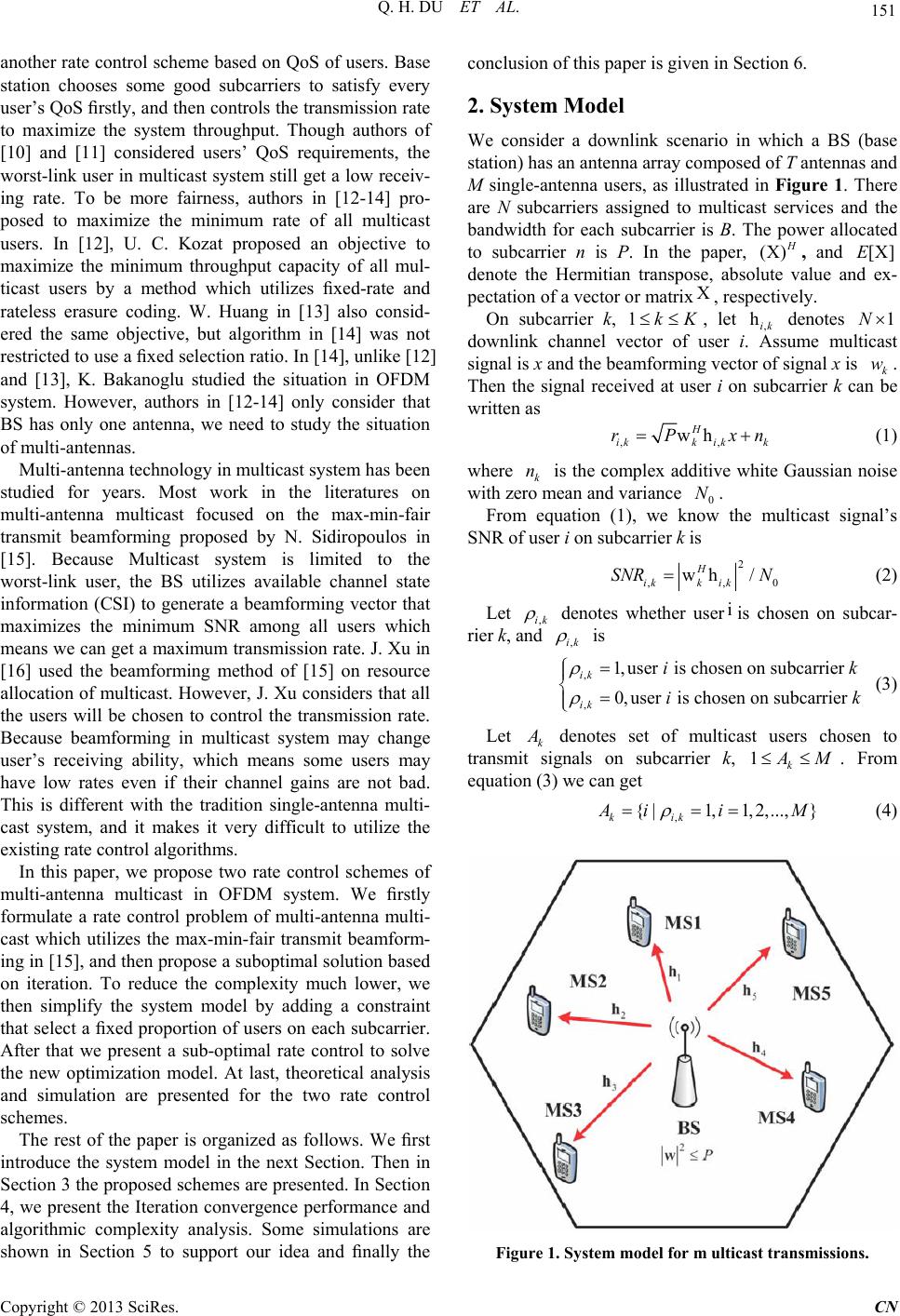 Q. H. DU ET AL. 151 another rate control scheme based on QoS of users. Base station chooses some good subcarriers to satisfy every user’s QoS firstly, and then controls the transmission rate to maximize the system throughput. Though authors of [10] and [11] considered users’ QoS requirements, the worst-link user in multicast system still get a low receiv- ing rate. To be more fairness, authors in [12-14] pro- posed to maximize the minimum rate of all multicast users. In [12], U. C. Kozat proposed an objective to maximize the minimum throughput capacity of all mul- ticast users by a method which utilizes fixed-rate and rateless erasure coding. W. Huang in [13] also consid- ered the same objective, but algorithm in [14] was not restricted to use a fixed selection ratio. In [14], unlike [12] and [13], K. Bakanoglu studied the situation in OFDM system. However, authors in [12-14] only consider that BS has only one antenna, we need to study the situation of multi-antennas. Multi-antenna technology in multicast system has b een studied for years. Most work in the literatures on multi-antenna multicast focused on the max-min-fair transmit beamforming proposed by N. Sidiropoulos in [15]. Because Multicast system is limited to the worst-link user, the BS utilizes available channel state information (CSI) to generate a beamforming vector that maximizes the minimum SNR among all users which means we can get a maximum transmission rate. J. Xu in [16] used the beamforming method of [15] on resource allocation of multicast. However, J. Xu considers that all the users will be chosen to control the transmission rate. Because beamforming in multicast system may change user’s receiving ability, which means some users may have low rates even if their channel gains are not bad. This is different with the tradition single-antenna multi- cast system, and it makes it very difficult to utilize the existing rate control algorithms. In this paper, we propose two rate control schemes of multi-antenna multicast in OFDM system. We firstly formulate a rate control problem of multi-antenna multi- cast which utilizes the max-min-fair transmit beamform- ing in [15], and then propose a suboptimal solution based on iteration. To reduce the complexity much lower, we then simplify the system model by adding a constraint that select a fixed proportion of u sers on each subcarrier. After that we present a sub-optimal rate control to solve the new optimization model. At last, theoretical analysis and simulation are presented for the two rate control schemes. The rest of the paper is organized as follows. We first introduce the system model in the next Section. Then in Section 3 the proposed sch emes are presented . In Section 4, we present the Iteration convergence performance and algorithmic complexity analysis. Some simulations are shown in Section 5 to support our idea and finally the conclusion of this paper is given in Section 6. 2. System Model We consider a downlink scenario in which a BS (base station) has an antenna array composed of T anten n a s and M single-antenna users, as illustrated in Figure 1. There are N subcarriers assigned to multicast services and the bandwidth for each subcarrier is B. The power allocated to subcarrier n is P. In the paper, (X) , and denote the Hermitian transpose, absolute value and ex- pectation of a vector or matrixX, respectively. [X]E On subcarrier k, 1kK , let , denotes hik 1N downlink channel vector of user i. Assume multicast signal is x and the beamforming vector of signal x is k. Then the signal received at user i on subcarrier k can be written as w ,, wh H ikk ikk rP xn (1) where k is the complex additive white Gaussian noise with zero mean and variance . n 0 From equation (1), we know the multicast signal’s SNR of user i on subcarrier k is N 2 ,, wh / H ikk ik SNR N0 (2) Let ,ik denotes whether useris chosen on subcar- rier k, and i ,ik is , , 1,user is chosen on subcarri er 0,user is chosen on subcarrier ik ik ik ik (3) Let k denotes set of multicast users chosen to transmit signals on subcarrier k, 1k M. From equation (3) we can get , {|1,1, 2,...,} kik iiM (4) Figure 1. System model for m ulticast transmissions. Copyright © 2013 SciRes. CN  Q. H. DU ET AL. 152 We use the method in [15] to calculate beamforming vector , which is used to maximize the minimum receiving SNR. The problem can be written as wk , w 2 , max min .. w {0,1}; 1,2,...,; 1,2,..., k kik iA k ik SNR st P kKi M (5) , {|1,1,2,...,}, 1,2,..., kik iiMkK Solving the equation (5), we can get the beamforming vector , . Then we know the transmission rate on subcarrier k is wk1kK * 2*, * log1min, ki i rBSNR iA kk M r r (6) So, the average rate of user i on all OFDM subcarriers is , 1/ ,1,2,..., N iikk n RqrNi (7) where ,2, ,2, 1,log 1 0,log 1 ikik k ikik k qB SNR qBSNR (8) In this paper, as illustrated in Figure 2, the transmitter decides users who decode signal on each subcarrier suc- cessfully by the perfect CSI information from all users. Once the user set on subcarrier k is determined, we can get the beamforming vector by equation (5), and then the ransmission rate is got from equation (6). Our objective is to maximize the minimum average rate of all multicast users. According to the above analy- sis, the optimization problem to be solved in this paper can be mathematically formulated as follows: , , max min ..{0,1}; 1,2,...,;1,2,..., ik i i ik R tkKi M (9) Figure 2. Framework of rate control for multi-antenna multicast. 3. Rate Control for Multi-Antenna Multicast There is only one optimization varialbe in equation (9), which is the matrix . From (3), we know that the op- timal solution involves evaluating all 2 K possible user selection combinations, and the one which maximize the minimum average rate is the optimal solution. For the high complexity of the brute-force method, in this section, we present a suboptimal solution by iteration. Then we simplify the optimal model by adding a constraint which selects a fixed proportion of users on each subcarrier, in order to have much lower complexity. After that we pre- sent a low complexity method to solve the new optimiza- tion model. 3.1. Iterative-Based Suboptimal Rate Control In this section, subcarriers are allocated to users in an iteration fashion. In each iteration, user who has the least rate is chosen and BS allocates a best subcarrier to that user. The suboptimal rate control can be described as follows: 1) Initialization: Calculate the beamforming vector wk on subcarrier k, ,kK1 by equation (5), when ,ik M1,{1, 2,..i.,} , which means all the users are chosen to transmit on subcarrier k. Calculate the capacity of user i, where 1,iM on subcarrier k by ,2 log (1) ik ik RB SNR , . Choose the user i which maximize , that is Let ,ik R ,ˆ ˆargmax . nk iR,ˆ 1,{ }. k ik i 2) Find useri whose rate is minimum, argmin . i iR If ,0, ik calculate the minimum rate denoted by min (,ik R) on subcarrier k when ,1. ik Choose sub- carrier on which the addition rate of minimum rate is maximum through * k *(,) min , argmax . ik ik k kR R We then denote the additional rate by . * k R If *0, k R or ,1, ik for {1, 2,..., },iM {1,2,..., },kK the algorithm terminates. Or let ** ,1,{ }, ik kk Ai and back to step 2). 3.2. Sub-optimal Rate Control Based on Fixed Proportion of Users Rate Control based on iteration needs many times of it- eration operation, each of which calculate once beam- forming problem. So it still has a high complexity. In this section, we propose to consider the situation that base station chooses fixed proportion of users on each subcar- rier to reduce complexity. Copyright © 2013 SciRes. CN 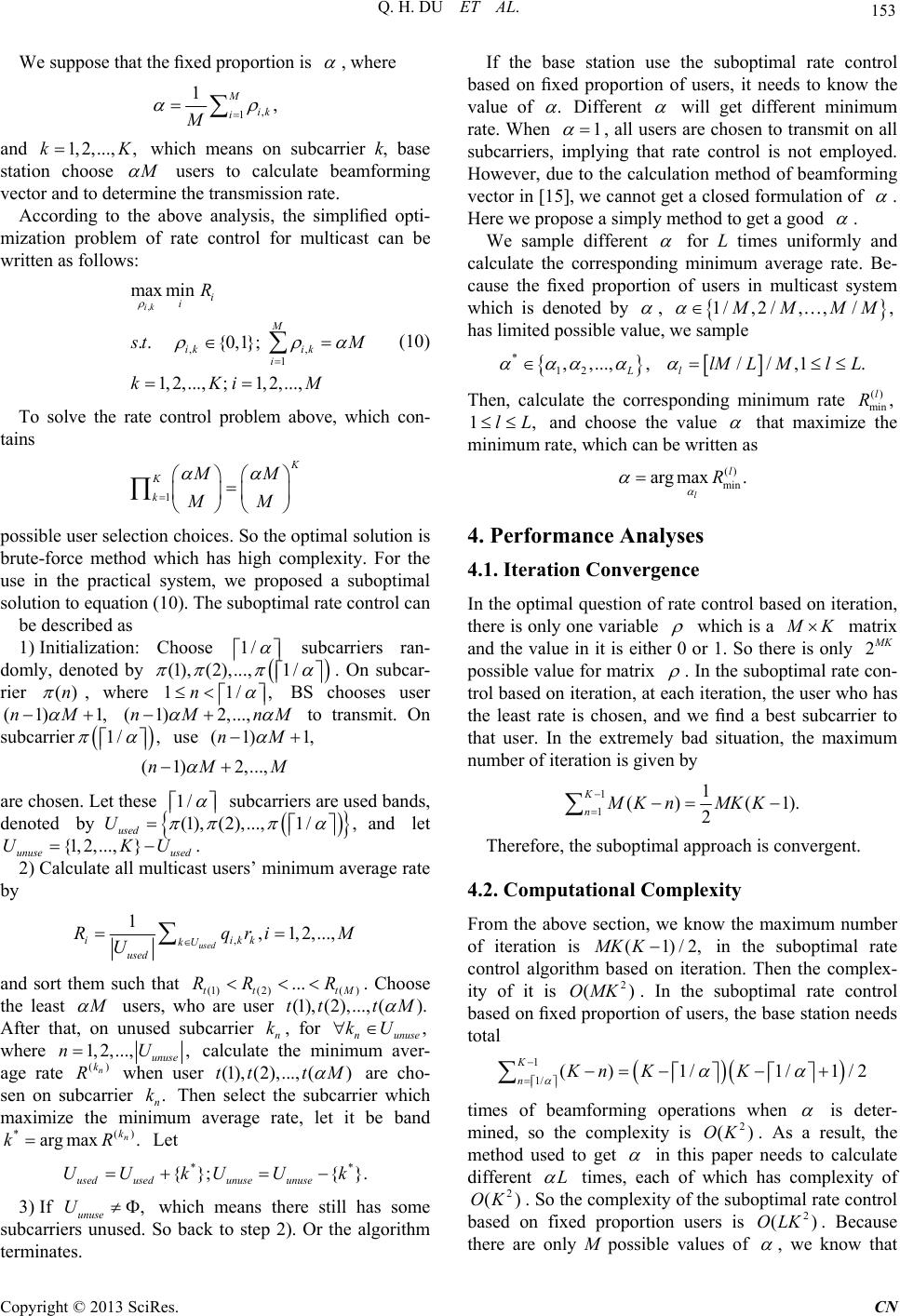 Q. H. DU ET AL. 153 We suppose that the fixed proportion is , where , 1 1, M ik i and which means on subcarrier k, base station choose 1,2,..., ,kK users to calculate beamforming vector and to determine the transmission rate. According to the above analysis, the simplified opti- mization problem of rate control for multicast can be written as follows: , ,, 1 max min ..{0,1}; 1,2,..., ;1,2,..., ik i i M ik ik i R t kKiM M (10) To solve the rate control problem above, which con- tains 1 K k MM MM possible user selection choices. So the optimal solution is brute-force method which has high complexity. For the use in the practical system, we proposed a suboptimal solution to equation (10). The suboptimal rate control can be described as 1) Initialization: Choose 1/ subcarriers ran- domly, denoted by /(1), (2),...,1 . On subcar- rier ()n , where 11/,n BS chooses user 1M(1)n, M( 1)2nM,...,n n , to transmit. On subcarrier 1/ , use (1) 1M 1)nM M ( 2,..., are chosen. Let these 1/ (1), ( U subcarriers are used bands, denoted byand let . 2),..., 1/, used U ..., }UK{1,2, unuse used 2) Calculate all multicast users’ minimum average rate by , 1,1,2,..., used iikk kU used Rqri U M and sort them such that (1)(2)( ) ... tt t RR R M . Choose the least users, who are user (1),(2),...,tt ( ).tM After that, on unused subcarrier n, for unuse where kn ,kU 1,2,n() n k R..., U,(1),(2),..., ()tt tM unuse calculate the minimum aver- age rate when user are cho- sen on subcarrier . n Then select the subcarrier which maximize the minimum average rate, let it be band Let k ) . ( *arg n k maxkR * {}; {}. usedusedunuse unuse UUkU Uk * 3) If , unuse which means there still has some subcarriers unused. So back to step 2). Or the algorithm terminates. U If the base station use the suboptimal rate control based on fixed proportion of users, it needs to know the value of . Different will get different minimum rate. When 1 , all users are chosen to transmit on all subcarriers, implying that rate control is not employed. However, due to the calculation method of beamforming vector in [15], we cannot get a closed formulation of . Here we propose a simply method to get a good . We sample different for L times uniformly and calculate the corresponding minimum average rate. Be- cause the fixed proportion of users in multicast system which is denoted by , 1/ ,2/ ,,/, MMM has limited possible value, we sample *12 , ,...,, L //,1 llM LMlL . , Then, calculate the corresponding minimum rate () min , l R 1lL and choose the value that maximize the minimum rate, which can be written as () min argmax . l l R 4. Performance Analyses 4.1. Iteration Convergence In the optimal question of rate control based on iteration, there is only one variable which is a K matrix and the value in it is either 0 or 1. So there is only 2 K possible value for matrix . In the suboptimal rate con- trol based on iteration, at each iteration, the user who has the least rate is chosen, and we find a best subcarrier to that user. In the extremely bad situation, the maximum number o f iteration is g iv en by 1 1 1 () (1 2 K nMK nMKK ). Therefore, the suboptimal approach is convergent. 4.2. Computational Complexity From the above section, we know the maximum number of iteration is (1)/2MK K, in the suboptimal rate control algorithm based on iteration. Then the complex- ity of it is . In the suboptimal rate control based on fixed proportion of users, th e base station n eeds total 2 ()OMK 1 1/ ()1/1/1 /2 K nKn KK times of beamforming operations when is deter- mined, so the complexity is . As a result, the method used to get 2 ()OK in this paper needs to calculate different L times, each of which has complexity of . So the complexity of the suboptimal rate control based on fixed proportion users is . Because there are only M possible values of 2 ()OK 2 K(OL ) , we know that Copyright © 2013 SciRes. CN 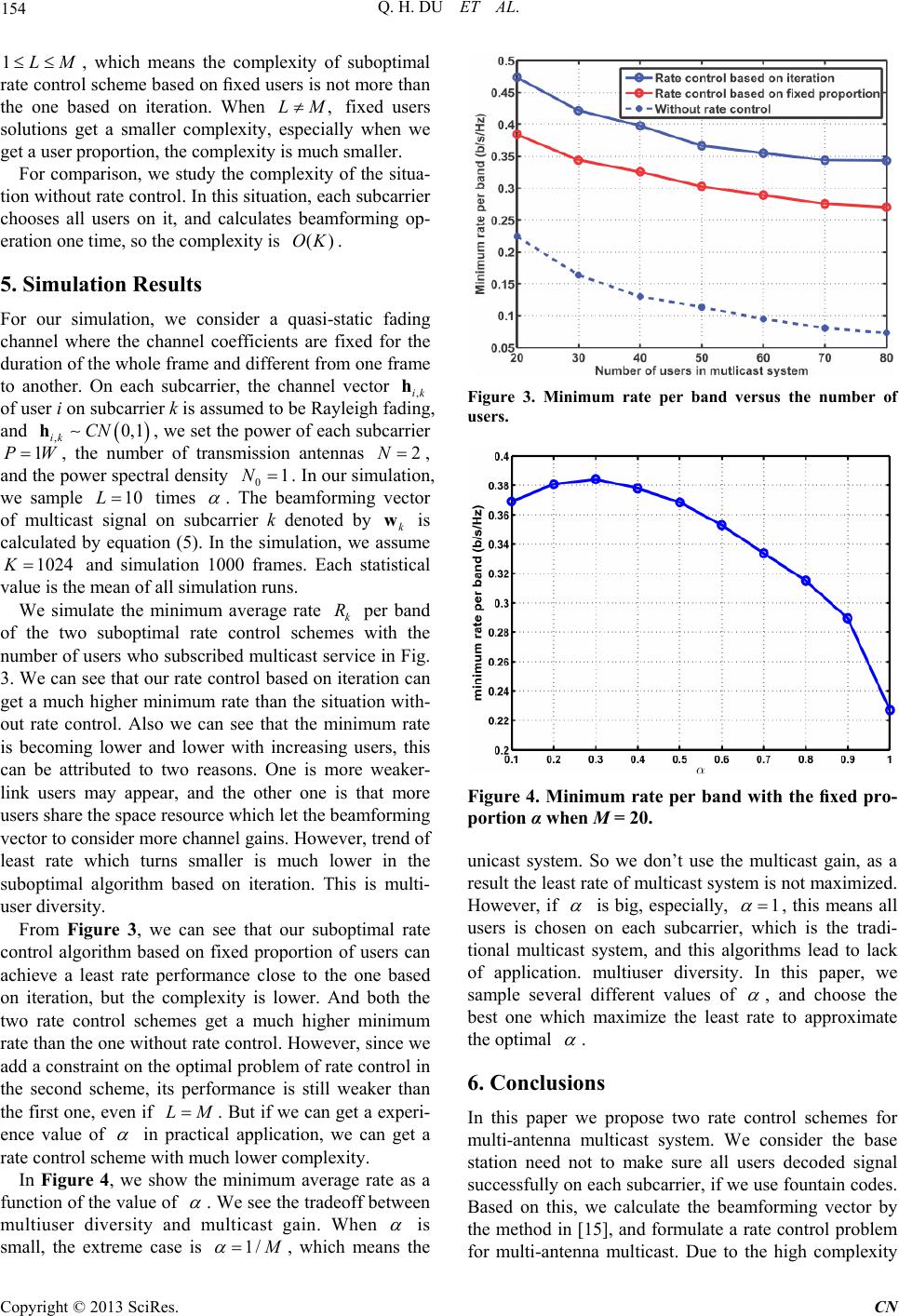 Q. H. DU ET AL. 154 1LM ,ik h 1PW , which means the complexity of suboptimal rate control scheme based on fixed users is not more than the one based on iteration. When fixed users solutions get a smaller complexity, especially when we get a user proportion, the complexity is much smaller. ,LM ()OK For comparison, we study the complexity of the situa- tion without rate control. In this situation, each subcarrier chooses all users on it, and calculates beamforming op- eration one time, so the complexity is . 5. Simulation Results For our simulation, we consider a quasi-static fading channel where the channel coefficients are fixed for the duration of the whole frame and different from one frame to another. On each subcarrier, the channel vector ,ik of user i on subcarrier k is assumed to be Rayleigh fading, and , we set the power of each subcarrier , the number of transmission antennas h 2 0,1CN N , and the power spectral density 0. In our simulation, we sample times 1N 10L . The beamforming vector of multicast signal on subcarrier k denoted by k is calculated by equation (5). In the simulation, we assume and simulation 1000 frames. Each statistical value is the mean of all simulation runs. w 1024K We simulate the minimum average rate k per band of the two suboptimal rate control schemes with the number of users who subscribed multicast service in Fig. 3. We can see that our rate control based on iteration can get a much higher minimum rate than the situation with- out rate control. Also we can see that the minimum rate is becoming lower and lower with increasing users, this can be attributed to two reasons. One is more weaker- link users may appear, and the other one is that more users share the space resource which let the beamforming vector to consider more channel gains. However, trend of least rate which turns smaller is much lower in the suboptimal algorithm based on iteration. This is multi- user diversity. R From Figure 3, we can see that our suboptimal rate control algorithm based on fixed proportion of users can achieve a least rate performance close to the one based on iteration, but the complexity is lower. And both the two rate control schemes get a much higher minimum rate than the one without rate control. However, since we add a constr aint on the optimal prob lem of rate control in the second scheme, its performance is still weaker than the first one, even if . But if we can get a experi- ence value of LM in practical application, we can get a rate control scheme with much lower complexity. In Figure 4, we show the minimum average rate as a function of the value of . We see the tradeoff between multiuser diversity and multicast gain. When is small, the extreme case is 1/ , which means the Figure 3. Minimum rate per band versus the number of users. Figure 4. Minimum rate per band with the fixed pro- portion α when M = 20. unicast system. So we don’t use the multicast gain, as a result the least rate of multicast system is not maximized. However, if is big, especially, 1 , this means all users is chosen on each subcarrier, which is the tradi- tional multicast system, and this algorithms lead to lack of application. multiuser diversity. In this paper, we sample several different values of , and choose the best one which maximize the least rate to approximate the optimal . 6. Conclusions In this paper we propose two rate control schemes for multi-antenna multicast system. We consider the base station need not to make sure all users decoded signal successfully on each subcarrier, if we use fountain codes. Based on this, we calculate the beamforming vector by the method in [15], and formulate a rate control problem for multi-antenna multicast. Due to the high complexity Copyright © 2013 SciRes. CN 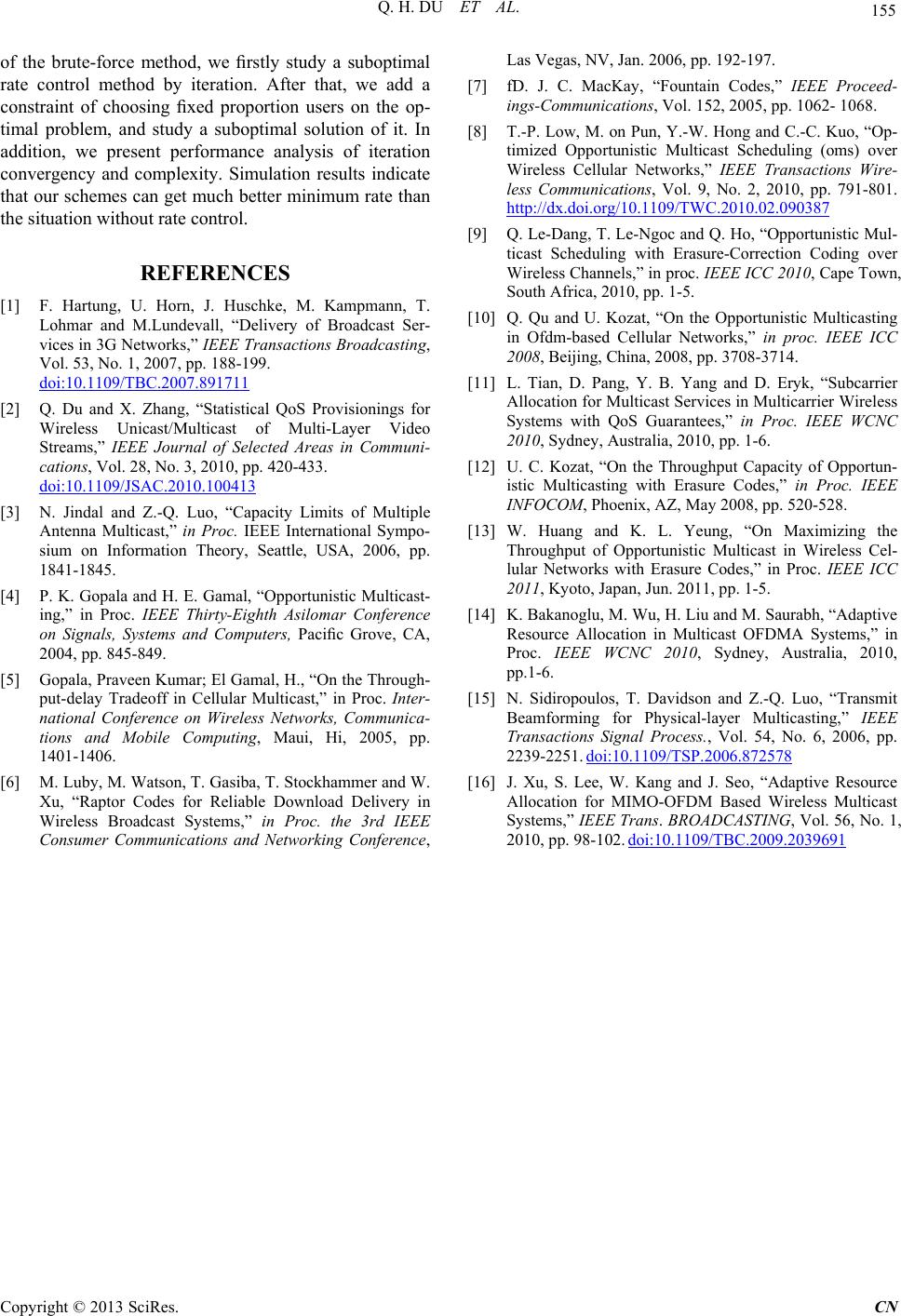 Q. H. DU ET AL. Copyright © 2013 SciRes. CN 155 of the brute-force method, we firstly study a suboptimal rate control method by iteration. After that, we add a constraint of choosing fixed proportion users on the op- timal problem, and study a suboptimal solution of it. In addition, we present performance analysis of iteration convergency and complexity. Simulation results indicate that our schemes can get much better minimum rate than the situation without rate control. REFERENCES [1] F. Hartung, U. Horn, J. Huschke, M. Kampmann, T. Lohmar and M.Lundevall, “Delivery of Broadcast Ser- vices in 3G Networks,” IEEE Transactions Broadcasting, Vol. 53, No. 1, 2007, pp. 188-199. doi:10.1109/TBC.2007.891711 [2] Q. Du and X. Zhang, “Statistical QoS Provisionings for Wireless Unicast/Multicast of Multi-Layer Video Streams,” IEEE Journal of Selected Areas in Communi- cations, Vol. 28, No. 3, 2010, pp. 420-433. doi:10.1109/JSAC.2010.100413 [3] N. Jindal and Z.-Q. Luo, “Capacity Limits of Multiple Antenna Multicast,” in Proc. IEEE International Sympo- sium on Information Theory, Seattle, USA, 2006, pp. 1841-1845. [4] P. K. Gopala and H. E. Gamal, “Opportunistic Multicast- ing,” in Proc. IEEE Thirty-Eighth Asilomar Conference on Signals, Systems and Computers, Pacific Grove, CA, 2004, pp. 845-849. [5] Gopala, Praveen Kumar; El Gamal, H., “On the Through- put-delay Tradeoff in Cellular Multicast,” in Proc. Inter- national Conference on Wireless Networks, Communica- tions and Mobile Computing, Maui, Hi, 2005, pp. 1401-1406. [6] M. Luby, M. Watson, T. Ga siba, T. Stockhammer and W. Xu, “Raptor Codes for Reliable Download Delivery in Wireless Broadcast Systems,” in Proc. the 3rd IEEE Consumer Communications and Networking Conference, Las Vegas, NV, Jan. 2006, pp. 192-197. [7] fD. J. C. MacKay, “Fountain Codes,” IEEE Proceed- ings-Communications, Vol. 152, 2005, pp. 1062- 1068. [8] T.-P. Low, M. on Pun, Y.-W. Hong and C.-C. Kuo, “Op- timized Opportunistic Multicast Scheduling (oms) over Wireless Cellular Networks,” IEEE Transactions Wire- less Communications, Vol. 9, No. 2, 2010, pp. 791-801. http://dx.doi.org/10.1109/TWC.2010.02.090387 [9] Q. Le-Dang, T. Le-Ngoc and Q. Ho, “Opportunistic Mul- ticast Scheduling with Erasure-Correction Coding over Wireless Channels,” in proc. IEEE ICC 2010, Cape Town, South Africa, 2010, pp. 1-5. [10] Q. Qu and U. Kozat, “On the Opportunistic Multicasting in Ofdm-based Cellular Networks,” in proc. IEEE ICC 2008, Beijing, China, 2008, pp. 3708-3714. [11] L. Tian, D. Pang, Y. B. Yang and D. Eryk, “Subcarrier Allocation for Multicast Services in Multicarrier Wireless Systems with QoS Guarantees,” in Proc. IEEE WCNC 2010, Sydney, Australia, 2010, pp. 1-6. [12] U. C. Kozat, “On the Throughput Capacity of Opportun- istic Multicasting with Erasure Codes,” in Proc. IEEE INFOCOM, Phoenix, AZ, May 2008, pp. 520-528. [13] W. Huang and K. L. Yeung, “On Maximizing the Throughput of Opportunistic Multicast in Wireless Cel- lular Networks with Erasure Codes,” in Proc. IEEE ICC 2011, Kyoto, Japan, Jun. 2011, pp. 1-5. [14] K. Bakanoglu, M. Wu, H. Liu and M. Saurabh, “Adaptive Resource Allocation in Multicast OFDMA Systems,” in Proc. IEEE WCNC 2010, Sydney, Australia, 2010, pp.1-6. [15] N. Sidiropoulos, T. Davidson and Z.-Q. Luo, “Transmit Beamforming for Physical-layer Multicasting,” IEEE Transactions Signal Process., Vol. 54, No. 6, 2006, pp. 2239-2251. doi:10.1109/TSP.2006.872578 [16] J. Xu, S. Lee, W. Kang and J. Seo, “Adaptive Resource Allocation for MIMO-OFDM Based Wireless Multicast Systems,” IEEE Trans. BROADCASTING, Vol. 56, No. 1, 2010, pp. 98-102. doi:10.1109/TBC.2009.2039691
|